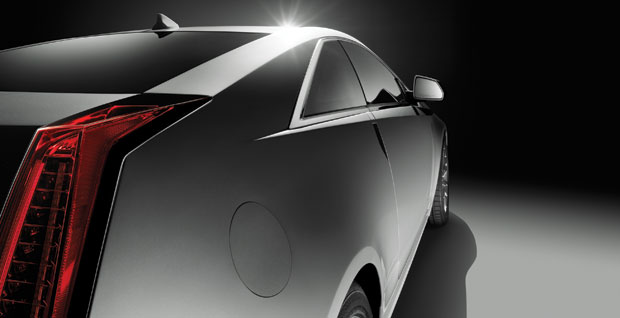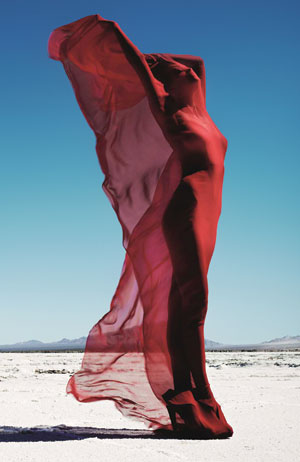The unique looks of car design often take flight from unlikely sources

WHAT LINES! | Rolls-Royce’s iconic ornament is reimaged as a woman in red, below, while the CTS Coupe, top, has an unmistakable profile.
CASEY WILLIAMS | Auto Reviewer
crwauto@aol.com
Earlier this spring, Rolls-Royce sponsored a fashion show in which models wore attire inspired by the company’s motorcars. I showed my partner a photo of one of the women, draped in red fabric, and asked him what she represented. It took him three seconds to identify her as the “Spirit of Ecstasy” hood ornament.
Auto designs can draw their inspiration from disparate fields. Harley Earl looked at the twin tail booms of a P-38 fighter plane and was inspired to create fins for Cadillac, which reached their zenith in 1959. Combined with sharp creases, eggcrate grille and stacked headlamps, fins make any modern Cadillac recognizable from Detroit to Shanghai.
 As I was flipping through photos, I showed him my picture of the 1973 BMW CSI 3.0. “Duh, it’s a BMW!” he exclaimed. While the car is 40 years old, its quad headlamps, twin kidney grille and “Hofmeister kink” in the rear windowline look handsome today.
As I was flipping through photos, I showed him my picture of the 1973 BMW CSI 3.0. “Duh, it’s a BMW!” he exclaimed. While the car is 40 years old, its quad headlamps, twin kidney grille and “Hofmeister kink” in the rear windowline look handsome today.
An early ‘60s drawing of the Ford Mustang also posed no challenge, given triple-barrel taillights and C-channel side surfacing. The features debuted on the 1964 1⁄2 Mustang and are loud and proud on the 200 mph Shelby GT500. Nobody will mistake the VW Beetle either. Dating from 1938, the Beetle isn’t the only famous Vee-Dub. Giorgetto Giugiaro’s two-box design for the VW Golf has proportions so clear a blind German could spy a GTI in the Black Forest.
Mercedes has terms for how it manages design: “Horizontal Homogeneity” and “Vertical Affinity.” The former decrees that all Mercedes in a generation look like part of a family, while the latter describes how each generation has features of previous models (think the three-pointed star, chrome grille, ribbed taillamps and gullwing doors.)
Mercedes isn’t alone. Hyundai’s popular “Fluidic” forms adorn the Sonata, Elantra and Azera; Ford’s “kinetic design” visually links products across the globe. You see the look on the Fiesta, Focus and 2013 Escape.
Designer Tom Peters’ Stingray concept from Transformers is so strongly evolved from Bill Mitchell’s ‘59 Stingray racer that you’d know from another dimension it is a Corvette. Thank all things holy that Peters has been tasked with the C7 ‘Vette.
“We did the Stingray as sort of a clandestine project. It was intended to be a way for us to capture the essence of Corvette,” he told me. “When the movie producers were looking for vehicles, they saw the Stingray and wanted it.”
Lincoln is in the throes of redefining itself. Designers should seek inspiration from Elwood Engel’s ‘61 Continental, famous for its starring role in the Kennedy Administration. The 2013 MKT crossover, wearing an updated waterfall grille, borrows the Continental’s slab sides and shoulderline. More gorgeous Lincolns are promised soon.
Some of this is smart marketing, but the rest is keeping the dream alive. Looking down the hood at a Mercedes star or over sexy Corvette fenders are aspirations some take a lifetime to realize. One thing is for sure: A half-century from now, you’ll still recognize these enduring design cues — even if draped in silk.
This article appeared in the Dallas Voice print edition August 31, 2012.

















